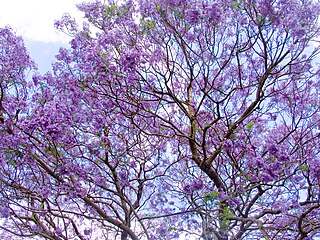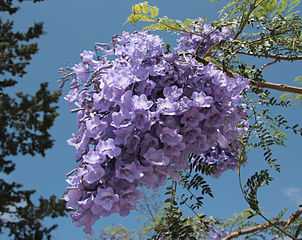Jacaranda trees grow rapidly in a tropical environment, adding around 10 feet to their height each year during their initial years of growth. However, their growth rate slows down when cultivated outside of their ideal tropical conditions.
The jacaranda plants’ observable receptivity to their environment is remarkable. They may quickly reach a growth rate of 3 to 4 feet per year when grown in a tropical location with the proper amount of moisture in the soil. For them to continue growing quickly, this moisture stability is essential. It’s crucial to keep in mind, however, that dry circumstances might severely limit their ability to thrive, leading to a less robust development.
Early on, jacaranda trees demonstrate their capacity for rapid growth, with some types reaching yearly height increases of up to 10 feet. To guarantee their ideal development trajectory, it is essential to supply plants with sandy, well-drained soil that is rich in organic matter. Additionally, their development trajectory is quite responsive to favorable circumstances and very sensitive to soil quality.
Jacaranda trees may grow to astonishing sizes when placed in the most advantageous environments. These trees have been known to grow more than 6 feet in a single year in certain reported cases. However, specimens that have been planted near to optimal circumstances often show such extraordinary growth rates.
Understanding Jacaranda Trees
Jacaranda trees are known for their rapid growth. These trees can grow up to 10 feet in their first year and reach a height of 30-40 feet in just a few years. With their stunning purple flowers, jacaranda trees add a vibrant and exotic touch to any landscape.
As an Amazon Associate we earn from qualifying purchases.
Table of Contents
They are also known for their fern-like foliage, which creates a beautiful canopy of shade. Jacaranda trees are often used in landscaping due to their striking appearance and ability to attract pollinators like butterflies and bees. Moreover, these trees are low-maintenance and drought-tolerant, making them a popular choice for regions with warm climates.
Factors Affecting Jacaranda Tree Growth Rate
Jacaranda trees grow at a relatively fast rate under favorable conditions. Factors like soil composition, environmental requirements, climate, sunlight exposure, and water availability play a crucial role in their growth. These trees thrive in well-drained soil with a slightly acidic to neutral ph level.
They prefer tropical or subtropical climates that offer warm temperatures and a frost-free period. Jacaranda trees also require ample sunlight to flourish, usually needing at least six hours of direct sunlight per day. Regular watering is essential, especially during dry periods, to keep the soil consistently moist but not waterlogged.
By meeting these requirements, gardeners can ensure optimal growth and development of jacaranda trees in their landscapes. So, understanding and addressing these factors is essential for anyone interested in cultivating these beautiful trees.

How long does it take a jacaranda to bloom?
Jacarandas grow relatively quickly, but the time it takes for them to bloom depends on how they are grown. If started from seed, it might take 7-14 years for them to bloom. Planting a sapling can lead to the first flowers appearing in 2-3 years.
It’s important to remember that the development of the Jacaranda’s distinctive blooms depends on a number of variables, including the kind of culture and environmental circumstances. When beginning from seed, the time it takes for the seeds to germinate after being covered with a thin layer of potting soil normally ranges from two to eight weeks. After then, there is a waiting period of around eight months until the first blossoming appears.
It’s interesting that the Jacaranda flowering show occurs in the spring and early summer, and it may linger for an amazing two months. This vibrant show often adorns the landscape between late April and mid-June, providing spectators with a stunning visual feast.
Jacaranda trees may live for an average of 50 years, which is remarkable for individuals who are curious about their potential longevity. Their longevity, however, might increase to a stunning 200 years if cared for in a suitable environment, highlighting their eternal beauty.
The vitex tree (Vitex agnus-castus) is a respectable substitute when the jacaranda tree is impractical owing to geographical restrictions or preferences. This alternative exhibits the capacity to withstand cooler temperatures while generating attractive blue flower spikes that are similar to Jacarandas. In contrast to the imposing 50-foot Jacaranda, the vitex tree is smaller in scale, growing to just around 25 feet in height.

What is the life span of jacaranda?
Jacaranda trees have an average lifespan of 50 years, but in favorable conditions, they can live up to 200 years.
These trees have extraordinary growth traits. Jacaranda trees may even be grown inside in their early years, typically the first few years, as long as they are placed in a bright, sunny area. They gradually develop during their growing process, reaching full size and maturity in around two decades. These trees have the amazing capacity to repair and grow again in the event of injury.
The lifespans of jacaranda trees may vary depending on their habitat, which is an intriguing observation. These trees may surprise expectations by lasting longer than the average 50 years when placed in very favourable environments. There are cases when jacaranda trees have survived for more than 150 years, demonstrating the degree to which they may thrive in the correct circumstances.
How far to plant a jacaranda tree from house?
I recommend planting a jacaranda tree at least 15 feet away from your house. Jacarandas thrive with sun, so choose a sunny spot that gets direct sunlight for most of the year. Avoid planting seedlings in the shade of larger trees. Ensure the tree is placed in rich, well-drained soil.
It is advised to plant the jacaranda at least 15 feet (about 4.5 meters) away from any surrounding structures to ensure a safe gap between the tree and your home. This separation helps avoid problems that may arise as the tree ages, such root incursion or branches encroaching on the house’s frame. This separation also enables the tree to develop without endangering the structure.
In addition, keep jacaranda seedlings out of the shade of bigger trees when choosing a planting spot. It’s crucial to choose a location that gets direct sunshine for the most of the day, even if some shadow throughout the day may be okay. This guarantees the tree’s strong development and abundant blooms.
The quality of the soil is also crucial. Plant your jacaranda tree in rich, well-drained soil for the best possible start. The roots should be able to develop and grow without getting soggy if the soil has a sufficient mix of nutrients and enough drainage. To the general health and lifespan of the tree, proper soil conditions play a crucial role.
Do jacaranda trees have deep roots?
Yes, jacaranda trees have extensive roots that can damage paths and fences, outcompete local species, and prevent other plants from growing under them.
In addition, very few other species may effectively flourish under a jacaranda tree owing to the structure of its root system. Due to the tree’s robust roots, which prevent the development of other plants, the region under the tree may become very barren. When conditions are right, the jacaranda’s dominance is so strong that it may grow dense thickets of seedlings, further suppressing nearby plants.
Also Read : Is A Jacaranda Invasive? (Answered)
Can jacaranda grow in hot weather?
Yes, jacaranda trees can grow in hot weather. They thrive in tropical or warm climates and prefer full sun. However, they might not flower as much and could grow slower in such conditions.
In ideal circumstances, jacaranda trees show rapid development when located in areas with the correct environment. Once they have established themselves and taken root, they can tolerate certain levels of drought. They are sturdy enough to resist recurring deep watering, which adds to their durability.
The possible impact of outside circumstances on their development, nevertheless, warrants caution. For instance, their development may be hampered if they are exposed to sand-laden ocean gusts, particularly in places close to the shore. Salty air may even prevent them from blossoming, reducing their general vigor.
It’s interesting to note that the jacaranda tree is native to northwest Argentina’s subtropical regions. This backdrop gives it the ability to withstand hot weather exposure and high temperatures. These trees thrive in areas with plenty of sunshine, and heat has less of an impact on their development capacity than salinity or high temperatures.
Jacaranda trees may grow and last for up to 200 years if given a good climate, however they normally survive for approximately 50 years. They mature in around 20 years and have the ability to regrow if harmed during the spreading of their seeds.
The vitex tree (Vitex agnus-castus), which is a good substitute for jacaranda trees, especially in colder climes, becomes an attractive choice. It can withstand cooler temperatures and has spikes with blue flowers that resemble jacaranda blossoms. It is noteworthy that the vitex tree grows to a height of roughly 25 feet as opposed to the jacaranda tree’s 50 feet.
In the end, subtropical regions free of cold temperatures are the best places to cultivate jacaranda trees. When exposed to plenty of warmth and sunshine, these trees grow at their most colorful. Additionally, they exhibit resistance to pests and illnesses as well as the capacity to withstand hot and dry circumstances.
How cold hardy are jacaranda?
In climate zones 12 through 21 and beyond, Jacaranda trees display excellent cold hardiness.
Cold Hardiness of Jacaranda Trees Across Different Climate Zones
| Climate Zone | Cold Hardiness of Jacaranda Trees |
|---|---|
| 12 | Jacarandas thrive with resilience against cold temperatures. |
| 13 | Jacaranda trees are well-suited to handle the cold in this zone. |
| 15 | The cold hardiness of Jacarandas is impressive in this zone. |
| 16 | Jacaranda trees exhibit strong resilience to cold conditions. |
| 17 | In this zone, Jacarandas display robust cold hardiness. |
| 18 | Cold temperatures are comfortably tolerated by Jacaranda trees here. |
| 19 | Jacarandas are well-adapted to the cold in this climate zone. |
| 20 | This zone’s cold weather is within the tolerance of Jacaranda trees. |
| 21 | Jacaranda trees thrive even when faced with colder temperatures. |
Conclusion
How Fast Do Jacaranda Trees Grow, The growth rate of jacaranda trees is truly remarkable. From their humble beginnings as small seedlings, these majestic trees can reach heights of up to 50 feet in just a few short years. Their fast growth is attributed to their ability to adapt to various soil conditions and their preference for full sun exposure.
Whether you are a gardener, a nature enthusiast, or just someone who appreciates the beauty of these flowering trees, understanding their growth rate can be fascinating. No matter where you live, be it in a tropical climate or a temperate region, jacaranda trees can thrive and add a touch of beauty to any landscape.
So, if you’re considering planting a jacaranda tree in your garden, rest assured that it won’t take long for it to grow into a stunning addition to your outdoor space.
Also Read : Jacaranda Tree Spiritual Meaning – What Does It Symbolize?
© 2024 Lotusmagus.com. All rights reserved. This content is protected by copyright. Visit Lotusmagus.com for more information.

